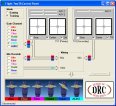Try It Before You Buy It:

Download our free simulator! The simulator is the best way to get acquainted with the Flight TwoTR. Download the simulator by clicking here. Unzip it on your computer anywhere you like, and run the "FlightTwoTR.exe" application with no installation necessary. All programmable features are supported including Airsoccer! Gaming Mode. The simulator can be used to program the Flight TwoTR when it is used with the DRC-Link. The Flight TwoTR can also be programmed using a Programming Cable that comes with the Flight TwoTR, so USB interface is not a requirement.
What's Required:
The Flight TwoTR supports remote DSM2 receivers. Please make sure you have what you need to bind these remote recievers to your transmitters. The Flight TwoTR only uses DSM2 compatible remote receivers. It does not use receivers with servo connectors. Receivers, receiver cables, servos, and batteries are not included.
The Flight TwoTR has a rich set of programmable features that are set either by a programming cable (included), or by a DRC-Link USB interface. The DRC-Link makes programming easier with a single button click. DRC-Link version 1.4 or higher is required to program the Flight TwoTR.
Full Range and Close Range Modes:
A single receiver for each transmitter is all that is required for models flown in schoolyards, gymnasiums, or other confined places. Two remote receivers are required for each transmitter for a total of four receivers to operate the Flight TwoTR in full-range mode. Receiver selections are automatic. No programming is required to select full-range or close-range modes.
Programming:
Programmable features of the Flight TwoTR include the following:
- Selectable Gain Channel: Any channel on the primary transmitter can be used to adjust the amount of control that is shared with the secondary transmitter.
- Channel Exclusion: Any channel on the primary transmitter can be removed from the mixing pool. Servos connected to excluded channels are controlled exclusively by the primary transmitter.
- Gaming Mode: Both transmitters are treated exactly the same in gaming mode and share an equal amount of control to the servos. The percentage of control from each transmitter is programmable. Extreme servo positions are limited when the combined transmitter commands exceed the maximum servo positions.
All features are programmable using the supplied programming cable, or using the simulator described above in the Try It Before You Buy It section with the DRC-Link. Refer to the Operator's Manual for programming procedures.
Specifications:
| Number of Channels | 7 transmitter channels, 6 servo outputs |
| Size | W: 1.1 inches, L: 1.2 inches, H: 0.33 inches |
| Weight | 0.19 Ounces |
| Voltage to Receivers | 3.3 volts |
| Input Voltage * | 4 to 9 volts |
| Static Current * | Less than 1mA |
| Voltage to Servos | Input Voltage |
| Servo Pulse Voltage | 3.6 volts P-P typical |
| Servo Pulse Range | 1.000mS to 2.000mS |
| Receiver Type | DSM2 |
| Servo Update Rate | 50Hz |
* Make sure servos can handle higher voltage if greater than 5-volts is used.
* Static current draw with no receivers or servos connected. Add 30mA for each receiver. Refer to servo specifications for additional current draw with servos attached.
What is Airsoccer?
Airsoccer is a fast moving game where two pilots control all aspects of one aircraft at the same time. The aircraft has two receivers, each bound to a separate transmitter. Each pilot has about 80% control over all functions. Combined commands that exceed 100% control are truncated to 120%. The combined commands from both receivers are sent to the servos. Up to six channels can be mixed. When one pilot turns the ailerons left, the other pilot can turn them right to neutralize the ailerons and steer with the rudder towards his or her goal line. Alternatively, use your opponents' actions against them by banking left even harder to flip the aircraft upside down, then push the elevator down to flip the vehicle up and over towards your own goal line. Airsoccer is always changing. It is fast, exciting, and great fun for spectators too!
Other Uses:
Large Gatherings such as birthday parties can make use of the variable gain feature where a student transmitter is passed between participants that want to fly a beginner's aircraft or run some other RC toy. A moderator can take over control to avert a crash, or just be there to provide a level of safety to make sure the vehicle does not go where it should not go. The student transmitter can be freely passed anywhere, to anyone, at any time, allowing all participants to safely take control without getting tangled up in a trainer cord.